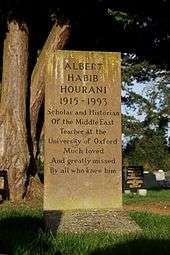Albert Hourani
| Albert Hourani | |
|---|---|
| Native name | ألبرت حبيب حوراني |
| Born |
Albert Habib Hourani 31 March 1915 Manchester, Lancashire, UK |
| Died |
17 January 1993 (aged 77) Oxford, Oxfordshire, UK |
| Resting place | Wolvercote Cemetery, Oxford |
| Occupation | Civil servant, lecturer |
| Language | English |
| Ethnicity | Arab people |
| Alma mater | Magdalen College, Oxford |
| Notable works | A History of the Arab Peoples (1991) |
| Years active | 1946–93 |
| Spouse |
Christine Mary Odile Wegg-Prosser (m. 1977; his death 1993) |
| Children | 1 |
Albert Habib Hourani (Arabic: ألبرت حبيب حوراني Albart Ḥabīb Ḥūrānī; March 31, 1915 – January 17, 1993) was a British historian, specializing in the Middle East. He was of Lebanese descent.
Background and education
Hourani was born in Manchester, England, the son of Soumaya Rassi and Fadlo Hourani,[1] immigrants from Marjeyoun in what is now South Lebanon (see Lebanese diaspora). Fadlo had studied at what later became the American University of Beirut and settled in Manchester as a cotton merchant[2] Albert's brothers were George Hourani, philosopher, historian, and classicist, and Cecil Hourani, economic adviser to President of Tunisia Habib Bourguiba. His family had converted from Eastern Orthodoxy to Scottish Presbyterianism and his father became an elder of the local church in Manchester. Hourani himself, in turn, converted to Catholicism in adulthood.
Fadlo Hourani tried to enroll Albert into a preparatory school in Manchester but it did not accept him as it did not take 'foreigners'; Fadlo instead opened an alternative school in which Albert studied until the age of fourteen.[3] He later studied at Mill Hill School, London[4] before attending Magdalen College, Oxford, where he studied Philosophy, Politics, Economics and History (with an emphasis on international relations in the politics section of the degree), graduating first in his class in 1936.
Career
He taught in 1938-39 at the American University in Beirut, the first time he had lived in an Arab country[5] In World War II he worked at the Royal Institute of International Affairs (aka Chatham House) and in the office of the British Minister of State in Cairo. After the war's end, he worked at the Arab Office in Jerusalem and London, where he helped prepare the Arab case for the Anglo-American Committee of Inquiry.
He began his academic career, which would occupy the rest of his life, in 1948, teaching at Magdalen College, St. Antony's College (where he created and directed the college's Middle East Centre), the American University of Beirut, the University of Chicago, the University of Pennsylvania, and Harvard. He ended his academic career as Fellow of St. Antony's and Reader in the History of the Modern Middle East at Oxford. Hourani trained more academic historians of the modern Middle East than any other university historian of his generation. Today his students can be found on the faculties of LSE, Oxford, Cambridge, Harvard, Yale, University of Pennsylvania, Columbia, MIT and the University of Haifa, among others.
Influence on Middle Eastern studies
Hourani's most popular work is A History of the Arab Peoples (1991), a readable introduction to the history of the Middle East and an international best seller. Arabic Thought in the Liberal Age 1789–1939 (1962) is one of the first scientific attempts at a comprehensive analysis of the nahda, the Arab revival of the 19th century, and the opening of the Arab world to modern European culture; it remains one of the major works on this subject. Syria and Lebanon (1946) and Minorities in the Arab World (1947) are other major works. He also wrote extensive works on the orientalist perspective on Middle Eastern cultures through the 18th and 19th centuries, and he developed the influential concept of the "urban notables" – political and social elites in provincial Middle Eastern cities and towns that served as intermediaries between imperial capitals (such as Istanbul under the Ottoman Turks) and provincial society.
The top book prize in the Middle Eastern studies field is named the Albert Hourani Book Award and it is given annually by the Middle East Studies Association of North America (MESA). Hourani was an Honorary Fellow of both MESA and the American Historical Association (AHA).
Personal life

In 1955 Hourani married Christine Mary Odile Wegg-Prosser (born 1914), while teaching at Magdalen College, Oxford. He died in Oxford at the age of 77. His widow died in 2003. Both are buried in Wolvercote Cemetery in Oxford.
They had a daughter, Susanna Hourani, who became professor of pharmacology and Head of Department in the School of Biomedical and Molecular Sciences of the University of Surrey.
References
- ↑ "The Horany / Hourani Connection". The Mahfood Family Site.
- ↑ Marmura, Michael E. (1984). Islamic Theology and Philosophy: Studies in Honor of George F. Hourani. New York: SUNY. p. Introduction.
- ↑ Seddon, Mohammad Siddique. "Muslim and Jewish Communities in Nineteenth Century Manchester" (PDF). Royal Holloway, University of London.
- ↑ Oxford Dictionary of National Biography
- ↑ Al-Sudairi, Abdulaziz (1991). A Vision of the Middle East: An Intellectual Biography of Albert Hourani. I.B.Tauris. p. 21.
Sources
- Al-Sudairi, Abdulaziz A. A Vision of the Middle East: An Intellectual Biography of Albert Hourani. London: I.B. Tauris.
External links
- "Albert Hourani: Islam, Christianity and Orientalism" (PDF). The College Record. St Antony's College, Oxford. 2003. Archived from the original (PDF) on May 11, 2006.
- "Albert Hourani (1915–93)". Bulletin of the Middle East Studies Association. Archived from the original on February 18, 2006.